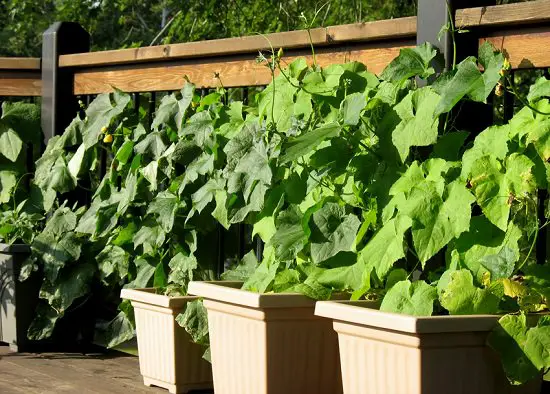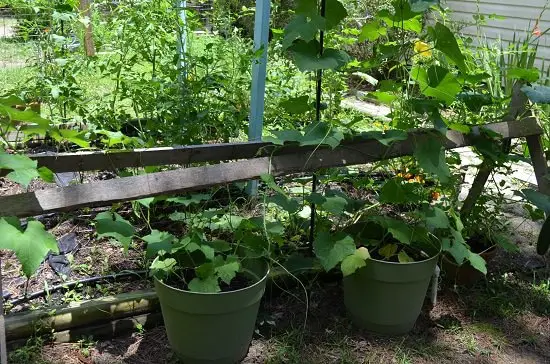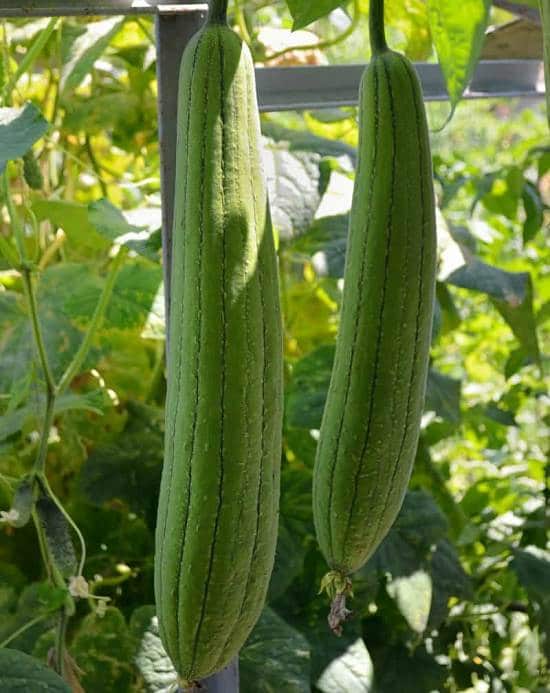Either plant it as a vegetable like Asians or grow it for a natural sponge by Growing Luffas in Containers! It is a lot of fun and rewarding as well!
Luffa, Sponge gourd or Chinese okra is a vine from the cucumber family. This fruit is grown and consumed as a vegetable popularly in China, Vietnam, India, and other subcontinent countries. Let’s know everything about Growing Luffa in Containers!
Botanical Name: Luffa cylindrica
Common Names: Sponge Gourd, Egyptian Cucumber, Vietnamese Luffa, Gilki, Dishrag Gourd, Rag Gourd
Check out our article on growing Cantaloupes in containers here!
Planting Luffa Gourds
Propagating Luffa Seeds
You can find luffa gourd seeds in a local nursery or garden center easily. Always buy new seeds for propagation. After procuring seeds, take a filer or sandpaper and scratch the outer layer a bit. Soaking them in warm water for 24 hours also helps in germination.
Poke your finger in the soil, making a hole of about an inch, and put the seeds in. Cover them completely and water moderately. Check the moisture every day and don’t let the soil dry out completely. The seeds will germinate in 4-10 days.
Choosing a Container
For growing luffa in containers pick one that is more than 12 inches deep and wide. It can be of any material, just make sure it has proper drainage holes at the bottom. A large 16-18 inches pot or bucket is right for the growth of one plant if you’re growing it for edible purpose.
Requirements for Growing Luffa in Containers
Position
Like other gourds and pumpkins, luffa loves warmth and expose to the sun as well. Place your luffa plant at a position, where it gets a minimum of 5-6 hours of direct sunlight daily.
Soil
The plant thrives in well-drained, loamy soil with a pH level of 6.0 to 7. When growing sponge gourd in pots, never use ordinary garden soil.
Watering
The key is to keep the soil slightly moist all the time without over-watering the plant. The roots may rot if there will be improper drainage and too much water is sitting in the pot.
Support
As it’s a vine plant, you have to provide support to it. Choose a tall trellis that doesn’t topple or tie it to a rope that goes up. This annual vine can be up to 30 feet long in optimum climate and if you keep removing the fruits regularly for cooking, therefore, you can also grow it on pergola or arbor.
For more trellis ideas, click here!
Luffa Plant Care
Fertilization
A few days after you transplant the seedlings, mix all-purpose, slow-release fertilizer in a weak dose in the soil or top your container with 20 percent well-rotted manure or compost. During mid growth, once the plant starts to flower, feed it once again with half-strength balanced liquid fertilizer.
Note: This second or third dose of fertilizer is not necessary and should be followed if you notice slow growth.
Pruning
It’s a fast-growing vegetable vine, which becomes too long in no time. You’ll need to prune it regularly for optimum growth. Get rid of diseased, damaged, burnt and out of shape stems and leaves often. Also, trim the entangled stems that are crowding and reducing the air circulation.
Pests and Diseases
Luffas generally suffer from powdery mildew, which often happens in humid weather. Avoid wetting the foliage to prevent it. For pests, you have to be careful about aphids, mealybugs, and slugs.
Harvesting Luffa
The plant will be ready to harvest in about 60-70 days, after sowing. Pick the fruits when they are tender and soft, about 6-7 inches in length. The more you wait, the more it’ll taste–“Not that good!”
If you want to use the sponge, then you have to wait till the green color fades. The fruit will be very light by then, in weight. This indicates that the fibers have started growing. Dry and peel the fruit to reveal the sponge within.
Uses
- It’s rich in dietary fiber, vitamin C and A, riboflavin, zinc, thiamine, iron, and magnesium.
- It’s great Vegan vegetable, which can be eaten raw just like cucumbers.
- You can use it in dishes in lieu of squash, zucchini or okra.
- In the Indian subcontinent, people make nutritious curry from it.
- Sponge gourd can be a great addition in soups, curries, chutneys, and stir-fries.
- It can also be steamed and added with soy sauce. Toss in browned garlic and chillis for added flavor!





I planted some seeds a few years ago ….in poor soil, as an experiment, around the 10th of May. I grew them as if they were bottle or birdhouse gourds. 15 seeds were enough to plant 3 hills. Only one hill survived, and they struggled, but i did get some good luffas. It is a beautiful plant. I don’t think it is adapted to high desert conditions without a little afternoon shade.
I’m confused, you say never use garden soil but you don’t see what soil to use? If not garden soil come out what soil? Thanks
His comment is incorrect. They will grow fine in regular soil. Put enough nitrogen in it and keep the soil moist, you will get luffas aka “chinese okra” in a few weeks after it starts blooming. I grow mine in old coolers. BTW, I can’t imagine eating them raw, just, NO. However, we love them stir-fried or breaded. Also, the information is incorrect about the order of harvesting mature luffa for a cleaning spong: When fresh off the vine and still a little green, just peel the matured luffa by working some of the fibers out of one end and then pull the whole mass of fibers out. If you wait until the luffa dries and then try to peel your in for a world of hurt and wasted time.